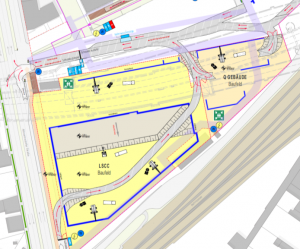Construction site traffic covers all movement of vehicles, equipment, and people on construction sites. There are various risks for severe accidents when operating self-propelled working machines on-site. These include collisions and, in the case of hydraulic excavators, getting hit by the excavator’s boom.
There are various factors which can contribute to accidents, for example, high intensity working, time constraints, complex tasks, missing or insufficient risk assessments, unfavourable weather conditions, and missing or inadequate traffic concepts.
If an effective traffic concept is missing, the number of unnecessary interactions between people and machines during on-site operations can be increased tremendously. This can also affect people who are not directly involved in the working process of machines. The reversing of machines, combined with people, is a high-risk operation which needs to be avoided whenever possible. Appropriate counter measures have to be considered and implemented.
It is vital that before construction starts, measures are taken to evaluate and coordinate the danger zone to ensure people remain outside of this area.
A well-conceived traffic concept should always be an essential part of health and safety documents, to ensure the separation of the machines and the people not directly involved with operating them. This should be specified from the very beginning of works being carried out and should be clearly defined and marked, with walkways and danger zones highly visible.
Depending on the size of a site, the traffic concept should not only include information about driveways and walkways, but also about loading areas, one-way traffic, turnaround possibilities, speed reductions and danger areas.
It is of major importance that the coordinators of the planning and execution phase give priority to the implementation of a traffic concept, which should be developed in close cooperation with the contractor. This will help reduce the risk of accidents and increase the safety level on-site significantly.

